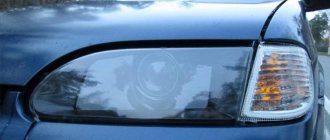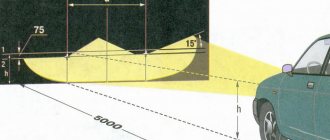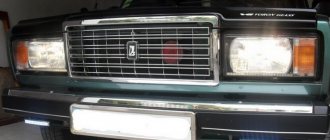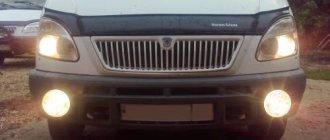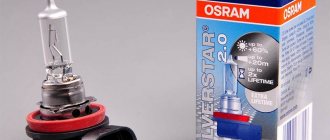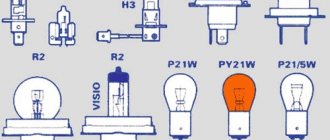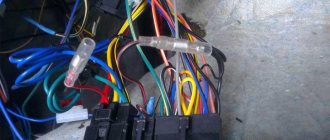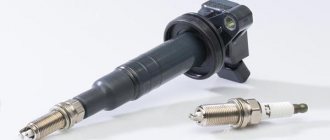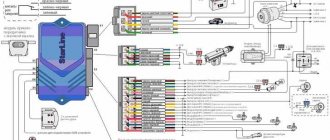REMOVING THE INSTRUMENT PANEL OF VAZ 2114 WITH YOUR OWN HANDS
The need to remove the “torpedo” can arise either quite unexpectedly - due to a breakdown of the stove or radiator, which can only be reached with the panel removed, or as planned - to replace a worn out “torpedo”.
We present to your attention a diagram of the fourteenth dashboard.
Let's look at its components:
- The main part of the structure, which, as a rule, is called the “torpedo” - all the auxiliary elements and components of the dashboard are fixed on it;
- Overlay for the VAZ 2114 panel, on which the air duct openings are located;
- Fixing brackets;
- Plugs;
- Ashtray;
- Right support frame (cross member);
- Right shield covering the wiring cable;
- Instrument panel VAZ 2114;
- Central bracket;
- Left wiring panel;
- Left support frame.
To do all the work at home we will need the following tools:
- Flat and Phillips screwdriver;
- A set of keys;
- Flashlight;
If you first study the theory of how to remove the instrument panel on a VAZ 2114, then the whole job will take you no more than 3-5 hours.
And so, let's move on to step-by-step instructions on how to remove a torpedo on a VAZ 2114 with your own hands.
First of all, it is necessary to remove the shields covering the wiring (in the diagram they are indicated by numbers 7 and 10). Let's start from the left. It can be removed quite simply - use a Phillips screwdriver to unscrew the three fixing screws; Next, remove the right shield - the procedure is the same, only there are 2 more screws in it
You must remove the screen carefully, since the plastic can damage the wiring located underneath it; Before removing the radio, you must remove the negative terminal from the battery. To dismantle the tape recorder, you need to disconnect the wiring block that connects it to the power supply, acoustics and antenna; Now you need to remove the cigarette lighter and ashtray, do not forget to pull out the light bulb from it; We take out the stove control knobs. To do this, you need to pick them out with a flat screwdriver or a knife, since the handles are connected to the base by grooves; We remove the knob for setting the power mode of the stove; to dismantle it you just need to pull it towards you; On the left and right sides of the instrument panel there are screws with which it is attached to the car interior
Unscrew them with a Phillips screwdriver; We unscrew the screws on the instrument block (speedometer), one of them is located on top, the second is located on the bottom of the block. The cover on the instrument panel can be easily removed after unscrewing the fasteners; We disconnect all wiring connected to the instrument panel. You can remove the arrows from the panel by carefully prying them off with a knife; Let's move on to the steering wheel. To remove the steering wheel on a VAZ 2114, you need to unscrew the bolts that secure the steering column bracket at the top and bottom. To do this you need a key of 8; On the right side of the headlight and rear window heating control buttons there is a plastic plug; you need to remove it and unscrew the screw hidden under it; Next, we dismantle the clamp that holds the heating control unit, after which we pull out the entire cartridge of the unit; We remove all the remaining decorative elements of the “torpedo”: the algorithm is still the same - unscrew the screws under the plugs and dismantle the plastic panels;
To do this, you need to pick them out with a flat screwdriver or a knife, since the handles are connected to the base by grooves; We remove the knob for setting the power mode of the stove; to dismantle it you just need to pull it towards you; On the left and right sides of the instrument panel there are screws with which it is attached to the car interior. Unscrew them with a Phillips screwdriver; We unscrew the screws on the instrument block (speedometer), one of them is located on top, the second is located on the bottom of the block. The cover on the instrument panel can be easily removed after unscrewing the fasteners; We disconnect all wiring connected to the instrument panel. You can remove the arrows from the panel by carefully prying them off with a knife; Let's move on to the steering wheel. To remove the steering wheel on a VAZ 2114, you need to unscrew the bolts that secure the steering column bracket at the top and bottom. To do this you need a key of 8; On the right side of the headlight and rear window heating control buttons there is a plastic plug; you need to remove it and unscrew the screw hidden under it; Next, we dismantle the clamp that holds the heating control unit, after which we pull out the entire cartridge of the unit; We remove all the remaining decorative elements of the “torpedo”: the algorithm is still the same - unscrew the screws under the plugs and dismantle the plastic panels;
If you plan to completely remove the panel from the car, then you need to disconnect all the wires, harnesses and wiring to the backlight bulbs located on the dashboard.
https://youtube.com/watch?v=Ab1W1UaFjJM
Preparation Tips
To replace two side light bulbs, you do not need to create special conditions and drive the car into the garage - the work is carried out in any convenient place. What to do:
- Disconnect the negative terminal of the battery.
- Remove components and parts that block access to the headlight units from the engine compartment.
- Remove the plastic protective caps covering the rear parts of the blocks where the light fixtures are located.
To change the side light bulb, you need to get to the headlights from the rear, having first removed the interfering elements. Depending on the make and model of the car, there may be an air filter housing, a battery, cooling system pipes, and so on near the headlight units. Decorative plastic panels and trims should also be removed.
Main reasons
Almost all problems related to automotive electrical systems can be solved in approximately the same way. You need to look for a potential or probable cause of malfunctions in the problematic object itself, or understand the system responsible for supplying power.
The situation is exactly the same with devices called brake lights. If they stop working, then you should look for the reason in one of the following points:
- There were problems with the fuse. It has oxidized or completely failed;
- There are faults in the lamps themselves or in one lamp, depending on how many stops are not working;
- The reason lies in the mechanism responsible for turning on the warning signal when the brake is applied;
- In the socket where the stop light is installed, the contacts have oxidized;
- More serious problems appeared related to damage to the wiring.
Sensor failure
The VAZ 2114 gearbox has a special sensor responsible for turning on the rear running lights. When reverse gear is engaged, a contact closes in the sensors, which sends a signal to turn on the rear lights. It often happens that this part is to blame for the breakdown of the rear running lights.
Location
The sensor is located on the gearbox housing, and it is screwed into it using a threaded connection. A connector with wires is put on the sensor to connect the sensor to the lights.
Below in the picture you can see the location of this part.
If you have problems with the rear lights, you need to look under the bottom of the car. Perhaps the problem is not even in the sensor, but in its connector, because the connector from the sensor can easily fall off, especially if you drive in deep snow.
Replacing the sensor
Replacing this part is quite simple; such work does not require special skills in car repair. You just need to prepare a 19mm open-end wrench.
Expert opinion
It-Technology, Electrical power and electronics specialist
Ask questions to the “Specialist for modernization of energy generation systems”
The rear lights of the VAZ 2115 do not light up - what is the reason, how to fix it. As practice shows, such gearboxes cost about 30-70 less than purchasing a new gearbox. Ask, I'm in touch!
The brake lights on the VAZ 2114 do not light up: reasons and methods for eliminating them
According to current traffic regulations, driving a car that does not have brake lights is prohibited, and this should be clearly remembered.
True, this rule can be taken into account in practice only when leaving the garage.
But what to do if the feet on the VAZ 2114 fail during the trip? Why not call a tow truck because of such a problem? In fact, this problem can be solved even on the road.
To do this, you only need to have a minimum set of tools:
- multimeter (even the simplest one will do);
- Screwdriver Set;
- sandpaper (for cleaning oxidized surfaces);
- set of wrenches.
In addition, it is good to have a fuse box diagram on hand.
Fuse failure. Broken wires in one of the sections of the circuit. Limit switch faulty. Bulbs burn out. Oxidation of contacts in lamp sockets.
Tail light repair
The most common reason for the failure of a VAZ 2114 rear light is the failure of a flexible printed circuit board or a connector made directly on it with conventional metallization. You can, of course, just buy a new printed circuit board and replace the faulty one with it, but, firstly, for how long?
And secondly, we are not looking for easy ways. So we will try to eliminate this malfunction on our own, at minimal cost and in such a way that it will last forever. Let's start with the connector for connecting the flashlight to the on-board network. It looks something like this:
The connector for connecting the rear light to the on-board network is part of a flexible circuit board and cannot be replaced separately
There are many reasons for this connector to fail. For example, we removed the power supply from the flashlight too often and simply partially erased the traces, which have a very small thickness of copper deposition on the plastic. Another reason is that the conductive paths next to the connector broke due to constant vibration. Well, the most banal thing is that the tracks burned out due to overload or short circuit.
Due to burnout of the conductive tracks of the flexible board, the rear fog lights do not light up
The photo shows a flashlight connector of a different modification, but the meaning of the problem is the same. All these issues can be solved with the help of a soldering iron, mounting wire and a regular six-pin (or more) connector with a mating part.
For repairs you will need this block with a mating part
We clean the connector contacts on the board using a student eraser (not sandpaper - the foil is very thin!) and service them.
We solder the wires from the block onto the tracks, not forgetting to mark them, and fill the soldering area with sealant or a hot glue gun.
Mounting block soldered to the rear light board
We cut off the standard power harness block, and in its place we solder the mating part of the new one. We assemble the flashlight, connect it to the on-board network - and check it. If we haven't messed up the wiring of the pads, then everything will work right away with a bang.
What to do if the tracks are burned out or broken? You can get out of this situation as follows. Immediately after the fracture, we clean the protective varnish from the tracks, tin, and solder the block. It will look like this:
You can solder the header anywhere on the flexible board.
You can, of course, limit yourself to this (until next time), but if you spend a little more time and effort, you can make more serious repairs. Flashlights modified in this way will serve faithfully for many years. Such a repair will save you from the eternal problem of contacts of flimsy standard sockets - this is also a very common malfunction of VAZ 2114 headlights.
To implement this idea, in addition to the six-pin block with a mating part (see above), you will need five cartridges from the VAZ 2106 direction indicators and a dozen terminals for them.
You will need 5 such cartridges and 10 terminals for them
We remove the lamps, standard sockets and flexible printed circuit board from the panel. We place the purchased cartridges in the right places on the panel and mark their centers. Special precision is not required here, the main thing is that each lamp shines into its own “window”. We drill holes according to the diameter of the base parts of the cartridges.
Holes for future cartridges
We insert the cartridges into the holes, mark the mounting holes, drill them, and screw in the screws. Now the cartridges are firmly fixed in the panel.
We secure each cartridge with two self-tapping screws
Using a mounting wire with terminals pressed onto it (you can crimp it with ordinary pliers and solder it to be sure), we assemble a circuit that repeats the layout of a standard flexible printed circuit board. To be sure, the terminals can be insulated with heat-shrinkable tubing, but in principle this is not necessary - the panel on which the cartridges are mounted is plastic. We solder our block to the ends of the wires.
This block will connect the rear light to the on-board network
We solder the mating part of the block to the power supply harness of the lights, having first cut off the old one. We solder it, not twist it together. The twist will oxidize in a week, and problems will begin again - sometimes it burns, sometimes it doesn’t. We insulate the solder joint with heat shrink or cotton (black rag) tape. PVC electrical tape is an extremely bad option. It can unfold over time. This kind of isolation is no good.
Everything is ready, you can connect and check
We admire our work for a couple of minutes, insert the lamps, connect them, check them. Is everything working as expected? We assemble the lantern and connect it.
The lantern is in place, all problems are solved for a long time
LED analog P21W
Why don't FZH work?
There are several reasons why FZHs can fail. Let's try to understand them.
There are a lot of reasons for the failure of the FZH, so the driver must know exactly how to eliminate this or that type of breakdown.
Removing the rear light board
To remove the board, you will need to perform a few simple manipulations:
- Open the trunk;
- Remove everything unnecessary from the space so that it does not interfere with your work;
- Remove decorative trim;
- Remove the plastic casing;
- Remove the back panel;
- Having gained access to the socket and the license plate lamp, you can remove the devices;
- Remove the reversing sensor mounting studs and the headlight itself.
Many people confuse the reverse sensor with the speed sensor, since these devices are located in close proximity to each other.
Checking the functionality of the sensor
If the taillights do not turn on, the culprit may be the reverse sensor, that is, a frog in the people.
Remove the contacts from the sensor and clamp them together, then turn on the ignition. If the light appears, the sensor needs to be replaced. If there is still no light, the integrity of the circuit is broken, but everything is fine with the frog itself.
- Place the car on a pit or overpass;
- Apply the handbrake;
- Remove the protection from the bottom, opening access to the gearbox;
- Remove the contacts from the old sensor;
- Place an empty container under the sensor and remove the frog. The container is needed because when the device is removed, oil will leak out of the gearbox;
- Remove the old frog, insert a new one in its place;
- Let the car sit for a while;
- Check the oil level inside the gearbox;
- If necessary, add oil to the required level;
- Reassemble.
Such repairs can be done with your own hands, and the cost will be approximately 250 rubles. This is exactly how much a new sensor for a VAZ 2114 costs now.
Problem with the light bulb
It is not uncommon for taillights to stop functioning normally due to the failure of the bulb itself.
- To replace it, you need to disconnect the block with wires and remove the contact panel from the flashlight. Here you just need to squeeze the side latches to remove the plastic panel;
- Apply a little pressure on the cartridge and unscrew it counterclockwise;
- Check the condition of the contacts and wiring;
- Screw in a new light bulb that matches the previously installed one;
- If necessary, before screwing in the new lamp, clean the contacts and test the wiring with a tester. There may be a break in the circuit, so a new light bulb will not work.
Useful tips Connection diagrams Principles of operation of devices Main concepts Meters from Energomer Precautions Incandescent lamps Video instructions for the master Testing with a multimeter
Complete electrical diagram of the VAZ 2114 with decoding
The complete package of electrical equipment of the VAZ 2114 can be divided into two types. The fundamental differences are due to changes in equipment depending on the year of manufacture and equipment of the car. In this case, the entire drawing can be divided into several zones.
- The engine compartment is responsible for providing voltage to sensors and instruments located directly inside the engine compartment.
- Salon compartment. The part is primarily used to connect the front and rear compartments.
- Instrument panel assembly. The pinout is displayed directly on the controls and dashboard. All elements of the on-board network are combined here and connected to buttons or indicators.
- Stern joint. The small module combines chain elements located at the rear of the machine. Typically, the segment is subject to frequent damage, which is due to the constant transportation of goods in the luggage compartment. When moving over obstacles, loads can damage sensitive equipment.
You can also separate small units – these are door units, windshield wipers and others. For ease of perception, each beam is considered separately.
VAZ 2114 instrument panel pinout
The terminals of all vehicle equipment are concentrated here. Due to the fact that the unit is located under the dashboard and is subject to constant condensation or fogging, some users treat it with hot melt adhesive. Even a thin coating can reliably protect the device from water ingress.
Elements are connected to devices or controls:
- 1 – switch key for heated rear glass;
- 2/6 – fog light switches, for rear/front module;
- 3 – plastic block for activating head optics and turn signals;
- 4 – fuse block;
- 5 – wiper mode switch;
- 7 – on-board system indication;
- 8 – supply voltage to the additional harness;
- 9 – dashboard;
- 10 – “male” for powering the on-board computer;
- 11 – terminal to the ignition device;
- 12 – for door wiring;
- 13/14 – fuses;
- 16 – ignition break;
- 17 – stove motor;
- 18 – secondary resistance of the stove;
- 19 – current supply to the ignition unloading relay;
- 20 – protective relay for rear fog lights;
- 21 – starter fuse relay;
- 22 – remote socket for a portable lamp;
- 23 – power supply for the cigarette lighter;
- 24 – for illumination of the glove compartment;
- 25-27 – illuminators;
- 28 – stove switch;
- 29 – tidy lighting with rheostat;
- 30 – stop switch;
- 31/32 – horn/hazard warning switch, respectively;
- 33 – backlight of the stove panel;
- 34 – fuse;
- 35 – protective relay for seat heating elements;
- Ш1/4 – mounting block jumpers;
- X1/2 – dashboard controls;
- A – protective ground output (usually black).
Electrical diagram of the VAZ-2115 car
Click to enlarge (580 KB)
Description: 1 — headlight unit VAZ 2115; 2-gear motors for headlight cleaners*; 3 — fog lights*; 4 — ambient air temperature sensor VAZ 2115; 5 — sound signals of VAZ 2115; 6 — engine compartment lamp switch; 7 — electric motor of the VAZ 2115 cooling system fan; 8 — VAZ 2115 generator; 9-sensor for low oil level indicator VAZ 2115; 10-washer fluid level sensor; 11 — front brake pad wear sensor; 12 — wire tips connected to the common windshield washer pump**; 13 — windshield washer pump VAZ 2115; 14 — headlight washer pump*; 15 — wire ends for connecting to the rear window washer pump on VAZ 2113 and VAZ 2114 cars; 16 — low oil pressure indicator sensor; 17 — lamp for illuminating the engine compartment of the VAZ 2115; 18 — wire lug for connection to the wiring harness of the engine control system or to the wiring harness of the ignition system on carburetor VAZ 2115 vehicles; 19 — windshield wiper gearmotor; 20 — starter VAZ 2115; 22 — coolant temperature indicator sensor VAZ 2115; 23 — switch for reversing lights VAZ 2115; 24 — low brake fluid level indicator sensor; 25 - battery; 26- low coolant level indicator sensor; 27-relay for turning on fog lights VAZ 2115; 28-mounting block VAZ 2115; 29 — brake light switch; 30 — plug socket for a portable lamp; 31 — lamp for illuminating the hydrocorrector scale of the VAZ 2115 headlights; 32 — parking brake warning lamp switch; 33-block for connecting the backlight; 34 — switch for instrument lighting lamps; 35 — steering column switch; 36 — alarm switch; 37 — relay for the heating element of the front seats of the VAZ 2115; 38-ignition switch VAZ 2115; 39 - rear fog light circuit fuse; 40 - fuse for the circuit of heating elements for the front seats of the VAZ 2115; 41 - door lock circuit fuse; 42 — front ashtray illumination lamp; 43 — ignition relay VAZ 2115; 44 — cigarette lighter; 45 — glove box lighting lamp; 46 — glove compartment lighting switch; 47 — electric motor of the VAZ 2115 heater fan; 48-additional heater motor resistor; 49-heater fan switch VAZ 2115; 50-heater switch illumination lamp; 51 — illumination lamp for the heater levers of the VAZ 2115; 52 — gear motors for electric windows of the front doors; 53 — right front door power window switch (located in the right door); 54 — gearmotors for locking front door locks; 55 — wires for connecting to the right front speaker; 56- gearmotors for locking rear door locks of VAZ 2115; 57 — wires for connecting to the right rear speaker; 58 — control unit for blocking the door locks of the VAZ 2115; 59 — wires for connecting to radio equipment; 60 — switch for headlight cleaners VAZ 2115*; 61- switch for heated rear window element of VAZ 2115; 62 — relay for turning on rear fog lights; 63 — block for connection to the heating element of the right front seat of the VAZ 2115; 64 — switch for the rear fog lights of the VAZ 2115: 65 — switch for the heating element of the right front seat of the VAZ 2115; 66 — fog light switch VAZ 2115*; 67 — switch for external lighting lamps; 68 — switch for the heating element of the left front seat of the VAZ 2115; 69 — block for connection to the heating element of the left front seat; 70 — wires for connecting to the left front speaker; 71 — left front door power window switch (located in the left door); 72-left front door power window switch (located in the left door); 73 — wires for connecting to the left rear speaker; 74-side direction indicators VAZ 2115: 75-light switch on the front door pillars; 76 — lamp switch on the rear door pillars; 77 — lampshade; 78-lobe of individual interior lighting; 79-block for connecting to the wiring harness of the VAZ 2115 electric fuel pump; 80 — trunk light switch; 81 — instrument cluster of VAZ 2115: 82 — trunk lighting lamp; 83 — display unit of the on-board control system of the VAZ 2115; 84 — trip computer VAZ 2115*; 85 — block for connecting the wiring harness of the engine control system; 86 — rear external lights of VAZ 2115; 87 — rear internal lights of VAZ 2115; 88 — block for connection to the rear window heating element; 89 — license plate lights; 90 - additional brake signal located in the spoiler of the VAZ 2115.
The order of conditional numbering of plugs in the blocks: A - block of headlights and headlight cleaners for VAZ 2115; B - cigarette lighter; B - VAZ 2115 mounting block, instrument cluster, VAZ 2115 ignition switch, windshield wiper and other electrical components (for blocks with a different number of plugs, the numbering order is similar); G — relay for turning on the rear fog light; D — alarm switch; E — gear motors for power windows and gear motors for locking door locks; F — interior lamp. In the instrument panel wiring harness, the second ends of the white wires are brought together into one point, which is connected to the instrument lighting switch (except for the white wire, from plug “4” of block “X2” of mounting block 28 to display block 83 of the on-board control system). The second ends of the black wires are also brought together to points connected to ground. The second ends of the yellow wires with a blue stripe are brought together to a point connected to plug “4” of the “X1” block of the VAZ 2115 mounting block. The second ends of the white wires with a red stripe are brought together to a point connected to plug “10” of the “X4” block of the VAZ mounting block 2115. And the second ends of the orange wires are also brought together to a point connected to plug “3” of the block “X4” of the VAZ 2115 mounting block.
* Installed on parts of manufactured Lada VAZ 2115 cars; ** On VAZ 2115 vehicles of various configurations, one common washer pump and electromagnetic valves for headlight and windshield washers can be installed (as on VAZ-2108 and VAZ-2109 vehicles). In this case, the pads 12 are connected to the washer pump, and the wires connected to pumps 13 and 14 are connected to the corresponding solenoid valves.
Lighting
Since the staff bumper does not have seats, they must be made by yourself. To do this you may need:
- Drill with a drill;
- Electric puzzle;
- File;
- Measuring instruments (tape measure, ruler, etc.);
- Marker;
Removing the front bumper of a VAZ 2114
,installation of PTF in
bumper
, in which there is no room for them. Continuation
On our channel you will always find a solution to your problems that you have when repairing your steel
Installation of fog lights is carried out with the bumper removed. Marking is first done on a bumper that has been cleaned of dirt. The optimal installation location is at the level of the lower air intake, but at some distance from it. It is advisable that the PTF be located strictly under the headlights.
First determine the distance at which the fog lights will be removed from the air intake. Then we'll figure out what size holes to cut. Decorative “glasses” will help with this. They consist of two halves. external (decorative) and internal (fixes the external part and the headlights themselves).
The outer half of the glasses has tabs on the inside to fit into the hole in the bumper. To determine the size of the hole, the dimensions of this mounting protrusion are measured. After we place the markings with the appropriate dimensions on the bumper.
Once the markings are complete, we will continue cutting the holes with an electric jigsaw. After this, the edges of the holes must be adjusted using a file
It is important to make sure that the outer part of the glass fits tightly into the hole
In these holes we fix the fog lights with bolted connections. All that remains is to fix the “glasses” headlights.
After installing the fog lights, we install the bumper on the car. This completes the first stage.
Advantages of tuning lighting elements
- Pull out the headlight, reflectors and reflectors, and then separate the glass.
- Using a marker, mark the places where the LEDs will be installed.
- On the inside, stick pre-prepared small round fragments cut from adhesive tape.
- Paint the lights and remove the tape after the paint dries.
- Install the reflectors using epoxy-based glue, and then treat each of the joints with sealant.
- Attach the LED boards to the machine wiring, marking them inside the lamp.
- Assemble the turn signal control units and restore the contacts.
- After this, install the modules with glue (video author - Alex Aitov).
Malfunctions and repairs
To repair a VAZ headlight, it must be removed.
In the case of rear lights, you should replace standard sockets and chips with high-quality ones, and seal the joints with sealant. This will eliminate problems with contacts and improper operation of modules.
If the front lights of the VAZ do not work, then you need to inspect:
- chips and wiring;
- lamps;
- glass condition.
If problems are detected in the wiring, the faulty parts are replaced. Burnt-out light elements are removed and new ones are installed. If glass is broken, it is not difficult to re-glue it with sealant or remove the defect using special glue.
If after all the work the headlights do not shine well, then the optics need to be replaced with new ones. To do this, you need to decide on the manufacturer and purchase a set of suitable lamps.
Construction and operation
Xenon and LED equipment is not installed in VAZ from the factory. The optics of the VAZ 2114 are equipped with several modules using a classic halogen lamp for the main light.
The headlight design of the VAZ 2114 is not complicated or modern. To replace the lamps, the optics do not need to be dismantled, and the beam is adjusted using built-in thumbwheels.
The disadvantages of front optics include the appearance of cracks in the glass due to stones or sudden temperature changes during operation.
Headlights
On sale there are lensed headlights for the VAZ 2114 for halogen and xenon. Sports modifications are covered with transparent glass with no reflective lines. The internal reflector of the lens is used to form the daw. In such VAZ optics, two separate lamps are used - for the high beam and low beam.
Factory installed front light design:
- block with reflector for low and high beam;
- separate lamp for side lights;
- turn signal made of transparent orange plastic.
A distinctive feature is a glass shield with special lines that direct a beam of light onto the road surface.
When installing modified flashlights, it is necessary to connect additional power, ignition units and adjust the beam position angle. To turn on the high beam using the standard button in the VAZ interior, you need to correctly identify the contacts and apply them to the module.
The advantages of installing sports optics include an increase in the light spot, while the disadvantages are additional manipulations with the wiring and the low quality of the proposed replacement.
Rear optics
If the standard front optics are reliable and of high quality, then the rear lights of the VAZ 2114 are often capricious and do not work properly.
Causes of malfunctions:
- poor quality of contacts;
- water getting on the board;
- thin plastic.
The VAZ 2115 also suffers from a similar illness and requires constant attention to the rear blocks.
Due to the poor quality of the contact group, the direction indicator, reverse signal or tail light disappears. When the board gets wet, the optics do not work properly and may blink as a brake light instead of a turn signal. Low-quality plastic bends when heated; due to the gaps formed, the flashlight fogs up and the lamps shine dimmer.
Recommendations
Comments 28
And that’s it., finally)) the mounting block turned out to be working, but still left a new one as a spare, because everything on the old glass heating fuses burned out. I replaced the rear boards and harnesses with wire plugs, all the wiring was rotted in the plugs, and the stop on the spoiler was also replaced with a new one, the old one somehow broke along with all the stops for the company.
Total. Stop in spoiler 250 rub. Boards cost 220 rubles each assembled. Flagella 20 RUR, mounting block from disassembly 1000 RUR.
The new stop spoiler is of much worse quality, the factory one was much brighter. The lamps in the new stop are terrible
We got around to replacing the mounting block with a new one. I rearranged everything and ooooopppppaaaa. The feet still don't work)))
To be honest, I don’t know where to dig anymore...
In the meantime, I’m waiting for my salary, I’ve already gotten used to pressing the rear PTF button when braking))) so that no one will correct my ass))) at least somehow attract attention that I’m braking)))
Still, I decided to disassemble the mounting block and the forecast is disappointing, fuse f4, which seems to be used for heating the rear window, the cigarette lighter and somewhere else, melts the board, everything around it is scorched, the board can’t even be reached, the plastic has already melted to it, next to fuse f3 it is is responsible for the brake lights, perhaps the whole reason is this, how reluctant I am to buy a new unit... but I’ll have to go on a hike. So far I have only treated it with liquid electrical insulation before replacing the unit
That's all we have. all 3 brake lights (spoiler) do not work. The light bulbs are intact, the grounds have been cleaned, the boards are in more or less perfect condition, the tracks are intact, the lamp serviceability relay has been replaced with a new one, the frog is working, the frog is receiving power. for a mystic?))))
In short: in the footsteps, today it was the same, two lamps stupidly burned out at the same time. The spoiler most likely has some wiring cut somewhere. Regarding the turn signal: this is a jamb of the board, either change the lights completely, or just start the car, turn on the lights, turn signal and lightly hit the glass with your palm several times until it is fixed (the contact comes off there). Cleaning doesn't help for long.
stripping does not save for very long. If the weather is rainy or winter, then a month at most (
Check the limit switch (frog) under the brake pedal, it may be damaged. Better yet, buy it and replace it right away, the price is reasonable.
I removed the wires from the frog, shorted it out, nothing lights up, I’ll buy a tester, I’ll have to see if there’s any current flowing to it at all
Check the limit switch (frog) under the brake pedal, it may be damaged. Better yet, buy it and replace it right away, the price is reasonable.
There are 12 V on the wires to the frog, so what?) I shorted the wires, everything is quiet. Let's go to the relay then
And if it burns out, the stops don’t burn? It is also responsible for the fact that if they do not light up, it signals or I do not understand its essence correctly
How can I check the relay? With others, it’s clear they click) should this also be?)))
if it’s burnt, you’ll know by the smell)) and you can open it, there are 2 latches on the sides, you can pry them off and the relay housing will come off
The problem with the blinking of the fog lights along with the turn signals was solved by cleaning the contacts of the headlight. My feet don't still burn. I'm looking at the relay
Are both feet missing? Look at the relay for monitoring lamp malfunctions (the largest in the ChYa) when I paralleled the stops with the PTF, the relay burned out from overload, but yours may have just burned out from a bad ground))
Checking the reverse sensor
It doesn't take too much effort to check your vehicle's reverse sensor (switch). In fact, this process can be completed in several steps.
Step 1: Locate the reverse sensor location. In almost all models it is located at the bottom of the gearbox housing. In fact, there are two sensors installed there: one to measure the speed of movement, and the second is a reverse sensor. To get to it, you will need to drive into the “pit”.
This is what the reverse sensor looks like
Step 2. Once you reach the sensor, disconnect the power wires from it.
Step 3. Connect the disconnected wires to each other (connect them).
Connect the wires together
Step 4. After this, you need to turn on the ignition and “stick” the reverse gear.
After checking the sensor, engage reverse gear again
What will it give? In fact, there may be different scenarios for the development of events after the wiring is closed.
If after this the lights are on. This indicates a faulty sensor condition that needs to be replaced.
If the lights still don't come on. This means that you need to look for the cause in the circuit, and the sensor itself most likely has nothing to do with it. Use a test light to measure the voltage coming from the sensor wire. If there is voltage, you need to check the contacts and boards.
Tuning taillights - main options
Tuning tail lights on a VAZ is most often:
- painting rear lights;
- use of tint film;
- installation of LEDs.
The surface is covered with glossy or matte vinyl film. It can be applied completely, partially in a certain place on the glass and removed at any time. Tinting material is produced in different colors and shades. The film has a protective function and can be used to protect the element from mechanical impacts of small stones.
The film is applied to the outer surface of the headlight in stages:
- Wash and dry the headlight unit.
- Wet the surface with soapy water.
- Cut the film to the required size.
- Remove the backing and apply it to the surface of the lampshade.
- Carefully smooth out from the center to the edges.
- Dry with a hairdryer.
- Remove excess film.
Varnish or paint is an economical option, but not always effective if you apply it yourself. To use, you need to wash and dry the lanterns well, then degrease and varnish.
Tinting should not reduce the brightness of lights by more than 15%. Although the traffic rules do not contain clear instructions on tuning rear optics, questions from the inspector may arise.
Tuning LED headlights have increased brightness and clearly define the dimensions of the car. More often, diode strips are used, which are installed around the perimeter of the rear stop.
Using LEDs
To tune the rear lights of the VAZ 2110, installing LEDs and painting the lampshade are most often used. LEDs are mounted in plastic reflectors after dismantling the headlight unit. For the VAZ 2110 it is recommended to choose two colors: red and yellow. The tapes are soldered and placed on the base inside the headlight unit.
To make the light as bright as possible, the base of the headlight is painted black. Tuning procedure step by step.
- Dismantle the headlight, remove the glass, remove the lamps.
- Fill the inside of the block with a thin layer of polyurethane foam.
- Give the foam the desired shape by determining the areas for installing the LED strip.
- Glue the LEDs onto the base inside the headlight.
- Install glass, connect wiring.
When installing LEDs at 6 Volt dimensions, stops and turns at 12 Volt, capacitors are installed, this prevents overheating of the optics.
LED characteristics
Modern single LEDs, matrix blocks, diode strips produced by well-known companies are distinguished by their high service life and reliability. Technical characteristics of LED blocks:
- service life more than 4000 hours;
- operate at minimum on-board voltage;
- good light data;
- no overheating occurs;
- are not subject to vibration and mechanical effects;
- variety of colors.
The luminous flux of such lamps does not dazzle the eyes and is visible from a great distance. Availability allows for inexpensive and high-quality repairs.
DIY LED tuning of rear lights
To perform LED tuning of rear lights you will need a minimum set of tools and an LED strip of the required length. Do-it-yourself tuning of rear lights on a VAZ 2110 step by step:
- Disassemble the headlight.
- Pull out the diffuser.
- Paint the reflectors black.
- Prepare the site and glue the LEDs.
- Solder stabilizers and wires from old lamps to the tape.
- Place the reflector on top of the diodes.
- Assemble the tuned spotlights and install in the reverse order.
LED pinout
Before connecting the wires, you need to pinout the LEDs. To make them glow, you need to pass an electric current through them in the direction from the anode to the cathode. To do this, a positive charge must be applied to the anode, and a minus charge must be directed to the cathode.
It is recommended to check the LED strip before installing it on the car.
Where does it short out most often?
I will try to make it a little easier for you to find the location of the short circuit, if, of course, this is appropriate in your case. But if all of the above methods do not lead to a positive result, this is the only option left. The wires going to the license plate lights, as well as to the trunk roof, most often fray and short out there. This wiring needs to be treated with electrical tape and nothing else.
Another problem area is the wiring from the rear of the fender under the carpet. There, too, you need to look carefully at everything and, if necessary, wrap it with electrical tape. Yes, there are cases when both bulbs burn out, but drivers refuse to believe this, checking everything, but not the headlights themselves. Start with them. That's all, good luck!
Installation and connection of front and rear PTFs on VAZ 2113, 2114, 2115
Before you begin installing fog lights, you will need to select a certain list of tools and additional elements. You can purchase a ready-made connection kit or select the necessary spare parts separately. When everything is prepared, you can mark on the front bumper a place for installing future headlights. The VAZ 2115 comes with standard holes from the factory, but in the case of the VAZ 2113 and VAZ 2114 you will need to work with a tool (a jigsaw or a drill). If you don’t want to damage the bumper, you can install the lighting fixtures on special brackets.
To install foglights in the front bumper, you need to make holes using a jigsaw or drill with drill bits, having previously completed the markings
You will need:
- file;
- drill and drill bits;
- electric jigsaw;
- roulette;
- marker.
Installation materials
As a rule, the kit for installing PTF on VAZ 2113, 2114, 2115 includes the following elements:
- headlights with bulbs;
- set of wires;
- electromagnetic relay;
- PTF power button;
- ties and clips for fixing wires;
- PTF connection diagram VAZ 2113, 2114, 2115.
The kit for connecting fog lights should include wires with terminals and connectors, a relay, a button
The installation of the lighting sources in question must be carried out using a button and an electromagnetic relay. The fact is that fog lights consume quite a lot of current and connecting directly to the ignition switch will lead to burning and subsequently burnout of the contacts. All this can contribute to damage to the wire insulation and the occurrence of a short circuit, which may result in failure of the electrical wiring.
Step-by-step installation and connection of PTF
To install fog lights, the following procedure must be followed:
- Installation of the headlight switch button in the cabin. You can choose any location for the element, as long as the driver can easily operate the key. Quite often, the part is installed instead of plugs on the dashboard.
- The grille with the dynamic head is removed from the front panel. Behind it there are two blocks designed to turn on the headlights, indicate the operation of the PTF and illuminate the button.
- Having placed the button in a convenient place, connectors are connected to it. After this, the grate can be put back in place.
- The relay is installed under the hood on the partition of the engine compartment near the mounting block. To remove it, you need to unscrew 2 nuts, lift it and find 2 pads (numbers 7 and 8).
- A block with a harness of four wires with contacts included in the kit is laid to the relay block.
- The connection of the wires that come from the PTF relay is carried out according to the diagram in the following order: the wire from the 30th contact of the relay is connected to block No. 8 of the mounting block at the 8th terminal, the 87th contact of the relay goes to the 1st terminal of the connector, 86 is “ground”, and 85 is connected with the 17th terminal of block No. 7.
- The positive wires are pulled to the PTF, the mass is mainly secured to the nut of the headlights. The “+” voltage is supplied to the fog lights from the 2nd and 3rd contacts of block No. 8.
- After all connections, the connectors are installed in the mounting block and secured.
As for the rear PTFs on VAZ 2113, 2114, 2115, on these modifications of the car such a light source is installed from the factory, i.e. another light bulb is used in the rear light. Control is also carried out from the passenger compartment using a button, but without fixing, since a slightly different relay design (electronic) is used. It’s worth knowing about this and not trying to install a latching key.
Video: installing PTF on a VAZ 2114
Checking the performance of PTF on VAZ 2113, 2114, 2115
After the lighting devices are installed and connected, you need to check how correctly everything works. To do this, just turn on the headlights and press the key that supplies voltage to the PTF relay, after which the headlamp lamps should light up. When the headlights are turned off, the PTF lamps should also go out, regardless of the position of the fog light button. After checking the functionality of the light source, you will need to adjust the light output so that oncoming drivers are not dazzled.
After installation and connection, we check the operation of the PTF: when the lights are turned on and the fog lights are pressed, the lights should light up, when the lights are turned off, the lights should go out
Fog optics are essential lighting equipment for any car. Such devices greatly facilitate travel in poor visibility conditions. If a certain car model does not have PTF installed from the factory, you can carry out the installation yourself. This does not require special tools or special skills and knowledge.
How to search for this device
It is not difficult to find the place where the reverse sensor is located. Two devices are installed at the checkpoint, one of them will be the DZH. It is installed at the bottom of the gearbox. This can be clearly seen in the figure below.
Location of the household farm
You can get good access to it when the machine is on an overpass, a lift or above an inspection hole.
The purpose of this device is that when reverse gear is engaged, it should light up a white light in the lamps. The lack of lighting does not mean that it is him. There can be many reasons for this. For example, a light bulb or fuse has burned out, or a wire has come off.
Replacing light bulbs
Now let's replace the rear light bulbs. We lift the trunk and look for a valve in the upholstery located opposite this device.
On the trunk side the lamp is covered with a Velcro flap
We open the valve (it is on Velcro) and observe the back of the flashlight with the power supply connected to it.
Rear part of the lamp VAZ 2114
We pull out the block by pulling it towards the central axis of the machine.
We release the latch located on the side of the lamp that is located closer to the center of the machine, and remove the board along with the lamps.
Removing the board with lamps
We unfold the board with the bulbs facing up and observe the picture shown in the photo in the first section of the article. All lamps are removed in the same way - by turning them counterclockwise. We find the burnt out lamp and replace it with a new one.
Replacing the reverse indicator lamp
Purpose
The front lights are called head lamps; they are located in the headlight unit in front of the car on both sides. They are the outermost ones in the lighting system, and owe their name to the fact that they show the width of the car to oncoming vehicles.
The rear lights are intended for exactly the same mission—so that you can be seen by those driving behind you. This is especially true when overtaking; you don’t want someone to hit your “swallow” without seeing its real size.
Hence the important advice: if it suddenly happens that you need to go at all costs and you discover that the light bulb in the left side light has burned out, replacing it with a new one is impossible due to the lack of one, don’t be lazy and move it from the right side. And we will tell you how to do this.
